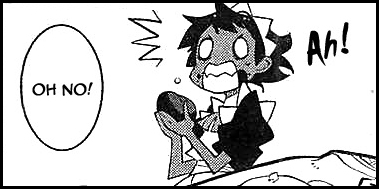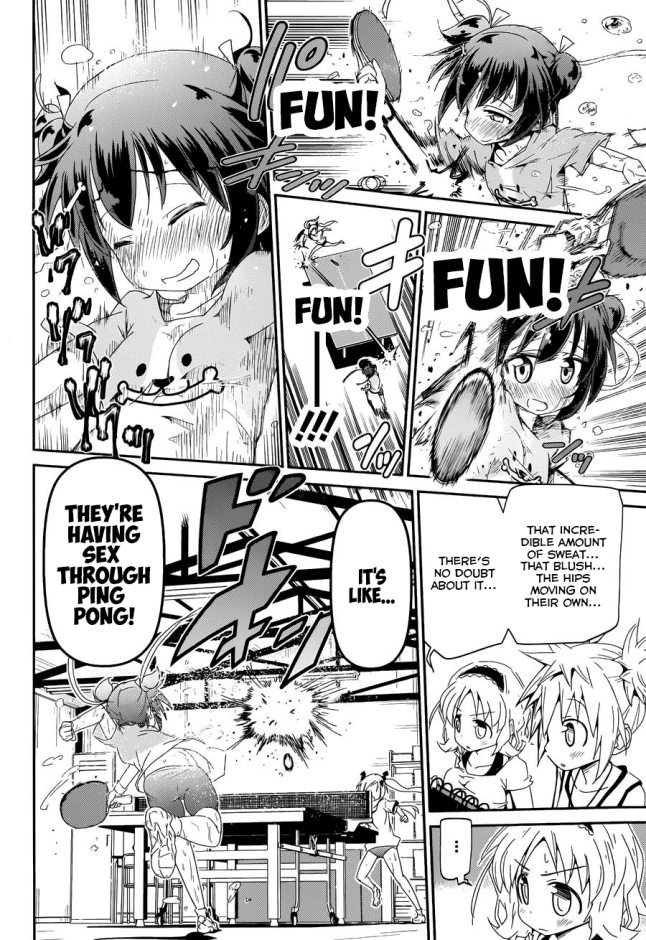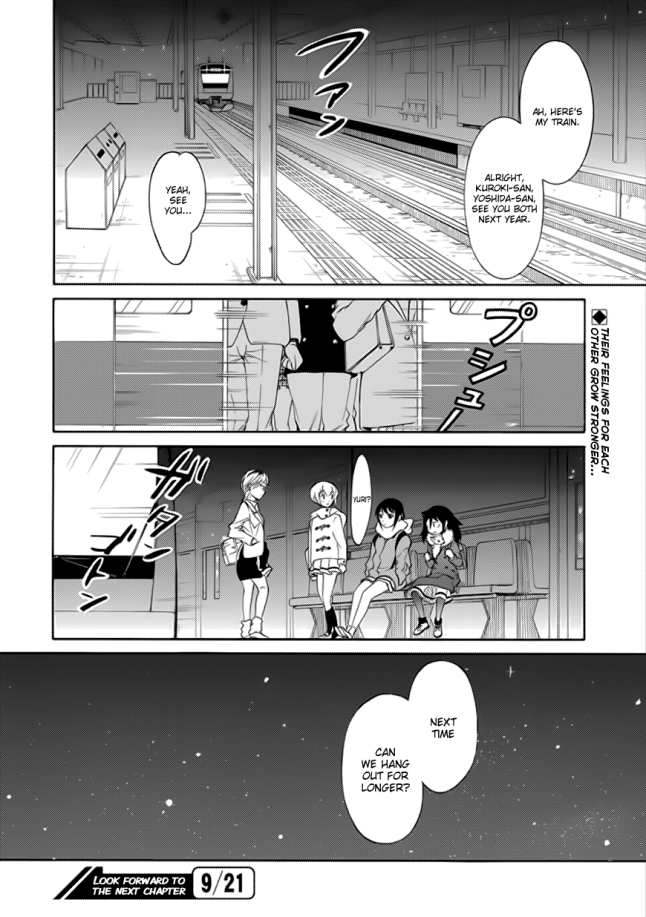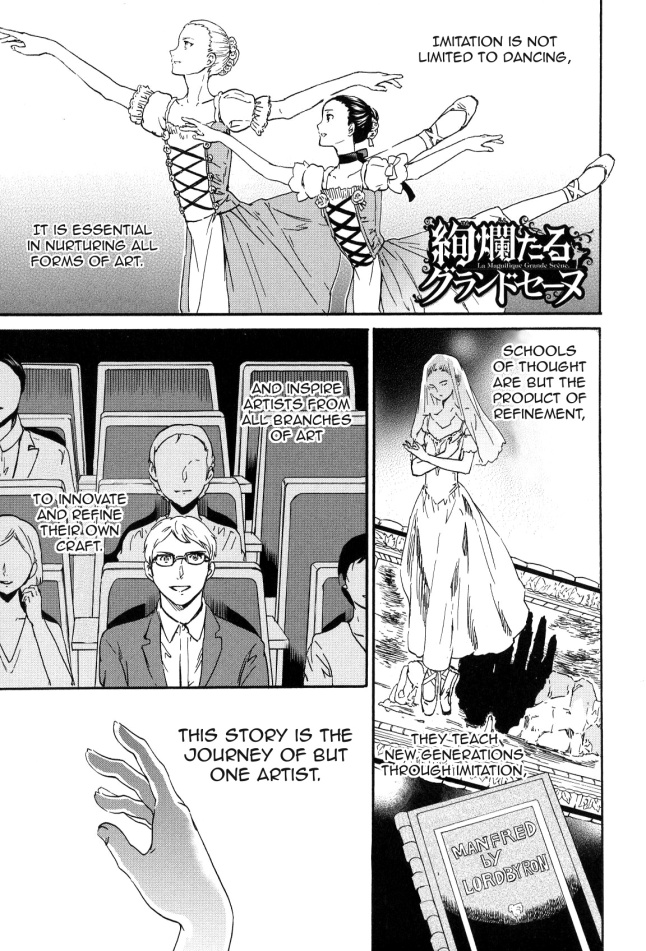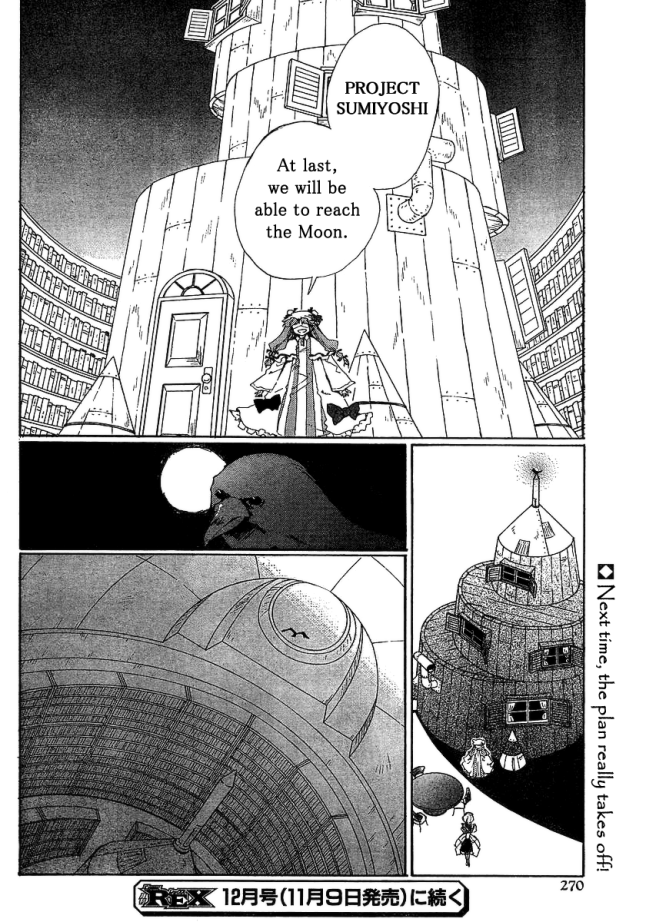
I’ve always thought this page was a good, condensed look at this series as a whole.
Welcome to my 1ooth recommendation, I’m reserving this for Tonari no Seki-kun, a manga I’ve long loved that seems to have sadly been rather forgotten. First things first: Tonari no Seki-kun (となりの関くん, My Neighbor Seki) by Morishige Takuma (森繁拓真) is indeed still ongoing, in case you thought it must’ve finished by now, or since you hadn’t heard of it for years it must be over. Scanlation for this series stopped years ago. The official translation by Vertical, however, has been caught up for a while. With 10 volumes out to date after almost 10 years of publication, one live action adaptation, and one anime series, Tonari no Seki-kun has not only maintained life, but has maintained and in fact nurtured new entertaining qualities, much to my genuine amazement.
Tonari no Seki-kun is basically a joke/gag/comedy manga. It’s a little difficult to put into a box, honestly (it doesn’t… FEEL like a gag manga), but it’s largely intended to make you laugh and to be found enjoyable. How it does this at its base is through the premise of “there’s a (largely silent) boy who hates school, so he goofs off all day instead of paying attention” + “the ways he goofs off are very creative/impressive”. If you know this one better, think Sakamoto desu ga?, but uh… more grounded in reality. It’s a strong premise; the titular Seki has many completely off the wall ideas and executions of those ideas in the manga, but what really, really makes this great is how the protagonist of the series, Yokoi Rumi, changes dramatically throughout it.

Rather organically, this series has really changed from its humble beginnings. I’m actually pretty sure Morishige-sensei didn’t really plan Seki-kun out much (at the very least, he’s of course admitted he didn’t expect it to last so long), but that isn’t a bad thing. Kind of similar to World Trigger (though perhaps not actively thinking about it like Ashihara-sensei), he’s created several characters with believable personalities and just… written from what they might do and how they might react given other characters’ acts, and situations they enter or deal with. Thus, naturally, Yokoi and Seki’s relationship changes quite a lot from how it starts (shockingly much over a well-paced amount of time), but they’re not the only ones. Perceptions of characters change between characters, rumors may spread and reputations are built — honestly aside from one student, nothing in this series doesn’t change in one way or another. Why is this so noteworthy? Well…
Shouldn’t this series be static?
Gag manga don’t like to change, and that’s because it’s easier to work in jokes with what you know (and furthermore, audience expectations eventually play a part in the strength of your comedy). Even my second favorite manga of all time, Hinamatsuri, is really subject to this. This and that situation might change a character’s status, but compare Nitta of the latest chapter to Nitta of the first and there is very little difference. Not a bad thing at all, of course! But that’s what makes Tonari no Seki-kun fairly amazing: by risking change and still coming out a winner. If you think a premise like this one would be repetitive and get old, you should be pleased to find it really doesn’t, and that’s because it stays fresh from start to latest in a variety of ways.

There isn’t much extra to explain in regards to the premise of this series; just that it wastes no time getting that premise across. Yokoi Rumi is a good student who sits next to Seki Toshinari, a clearly bad student. When the series starts, Yokoi has been next to him long enough to expect antics out of him, but not necessarily enough to expect how far those antics will go. We get a decent snapshot of what both characters are like (though mainly we learn about Seki) and an idea of how the series will typically go. Seki’s first “game” is lining up dominoes, easy enough to understand since very quickly, his activities become very esoteric (and part of the fun is trying to figure out what he’s thinking).

By the way, this is a curious case of art evolution since Morishige’s style really does change a lot over the series’ run, but you probably won’t notice at all.
He’s pretty unreasonably vindictive.
His imagination plays a big part in whatever he does.


And finally, he cleans up disturbingly fast and well (not to mention how he hides his activities in the first place — I’ll explain that briefly later).

As for Yokoi, it’s still too soon to get a complete picture of her personality. At first, it seems like she’s a prim, proper, and polite type I guess? That’s… somewhat inaccurate. I suppose the first thing we clearly learn about Yokoi is that she has a burning sense of justice.

Frequently during Seki’s games (which often involve cruel, “villains win” plots or the abuse of cutesy creatures/characters) Yokoi is compelled to interfere because she refuses the plot Seki has come up with. It’s not much to begin with, but over time her involvement gets more and more extreme. Aside from this, the next thing we learn about Yokoi is that she loves cute things.
But, seriously, the extent of her adoration of “cute” cannot be underestimated. Last important thing we learn about Yokoi is that, despite shrinking to some of Seki’s glares earlier and getting flustered repeatedly, she does have a backbone, and quite a bit of one at that. This is good. Now we know she won’t simply be a forever fretting observer.

These are her core traits, and with them you might be able to predict the places she’ll go as a character… but you probably won’t, actually. I mean, she goes places.
That said, once we have this basic formula and the foundations of these two main characters, the series just moves from there. Here, have a chapter:
When going through the series rapidfire and selecting useful pages, I grabbed maybe 8 whole chapters that I’d have liked to show off entirely but, this isn’t a manga hosting site. Settle for one, or see for yourself what it’s like by reading the manga!
Volume 1 is good, volume 2 gets better, so on, so forth. Interesting to note: even in volume 1 we see Morishige-sensei introducing ideas that stray from his standard “Seki plays, Yokoi commentates” base. He introduces the character Uzawa and starts one of a few repeated “activities” in the series: the Robot Family.
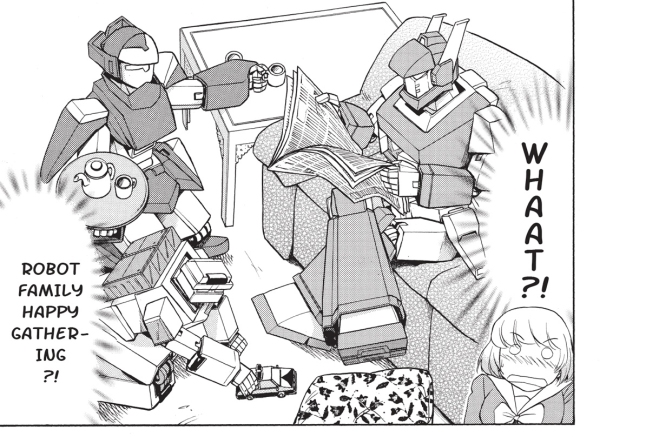
(I don’t notice them all the time but Morishige sure loves giving Yokoi some hilariously goofy reaction faces)
Uzawa is a wretched little ball of chaos that ruins everything because ruin is his nature (this, too, cannot be underestimated). The Robot Family is perfection; a troupe of lovely father, mother, and son bots that Seki treats with a surprising amount of affection (for the most part). Volume 1 marks their first appearance, and just like Uzawa it will most certainly not be their last. Oh and, side note: it’s not a Ouija board or game Seki’s playing up there, but I’ll talk more about the official translation later.


For now instead let’s talk more about those extra, not-to-norm additions to the series.
The main characters of Tonari no Seki-kun are strong, and thus are its main draw, but to keep things from getting stale every once in a while Morishige-sensei throws in these other characters as an element or focus of the chapter, or he brings an old “game” out for a “further adventures of” style thing. He does this sparingly, and honestly even when reading this in the condensed form of one volume a day, I kept feeling like these recurring characters and activities were a refreshing spice that I was always happy to see. Morishige seems to have figured out an optimal pace for distributing these, and I applaud him. But enough of that, who is this girl in the preceding two images?

This is Gotou. Gotou is a shipper with a bit of a twist.


The twist is that Gotou is a goddamn pervert.
Gotou’s thing is that she really likes Yokoi (maybe that way), but she “discovers” while staring afar one day that “Seki and Yokoi are secretly dating”. Through a misunderstanding, she becomes Yokoi’s friend (though Gotou’s yuri heart seems a bit hurt by her assumed revelation).
The reason I brought up how these recurring appearances are distributed nicely is that by all means, Gotou should be an awful character. She’s the “shipper”, a character type I despise, but along with her having a little change of being really oddly sexual in most of her interpretations and delusions over Seki and Yokoi’s reactions, she doesn’t appear often and thus when she does appear, I’m amused by her again.
She really is just plain funny, I must say. Also the second layer of “Yokoi observing Seki while being observed by Gotou” just tickles me so thoroughly. I like Gotou. I delight in her chapters, in Uzawa’s chapters, in Robot Family chapters, in Seki’s sister showed up chapters — yep, Seki’s family also plays a role in this series.

And they are so. Cute. Oh my GOD. Holy shit.
Every time Seki’s family appears it’s like the manga goes to 11 out of 10 (other times it does this involve Yokoi breaching previous barriers as she gets more used to Seki). It’s no surprise to me, then, that Morishige-sensei deploys them extremely rarely. I think you can count all of their appearances so far on one hand, though I’m not sure. Maybe one and a half. I am legitimately compelled to squeal when I observe and say “Whoa, is that Seki’s mom!?” I guess what I’m really getting at with all that I’m saying is that wow, Morishige deserves his nearly ten years and actually ten volume of publication. He has pulled off keeping a clear, obvious, “I’ll be dead in two or three volumes” series fresh, and I really think he isn’t thinking about how he’s really doing this on the whole, which again, makes me want to applaud him. Why do I think he doesn’t think about it? He kind of admitted that.
This is from volume 10, in which he announced a hiatus that the series has since left never mind, I’m not certain as to what its actual release schedule is like now. Now keep in mind, I am certain he thinks about “making up new things”, specifically for Seki to do. He has a genuinely bewildering amount of ideas to be honest, and I don’t know how it took him so long to exhaust himself even somewhat of them. BUT, he specifically cites a lack of surprise being a concern for him.
While surprise is definitely a great element of this manga for various reasons, at this point I am not as concerned with being surprised by Seki’s games as I am concerned as to what I will see next as the main relationship morphs and Yokoi’s character shifts. This is what I meant from my introduction: the series now carries new appeal. I’m not going to convince Morishige to write differently or say “no! you’re wrong! I like it and don’t care about the surprises!” because demonstrably the way he writes has been working well (maybe he does think about all of this, and just SEEMS to write splendidly off the cuff). I just really want to point out that if he’s worried about readers losing interest, at the very least in the West this is surely not the case. Having a story time through all the volumes in 2018 was one of the highlights of the year for me so far, being 1) reminded of a series I’d forgotten existed and 2) thoroughly amazed at where the series went and just how good it’d gotten. To explain…
Yokoi Rumi is nearly a victim of corruption by Seki, as over time she realized how genius her neighbor is and how truly impressive his operations are. She still hates his villainous streak, but she, uh… she REALLY goes out of her way whenever she’s truly fascinated by one of Seki’s games. Absolutely hilariously, this almost flips the tables on Seki, who becomes annoyed with Yokoi not because she’s trying to stop him from goofing off, but because oh god you’re so annoying stop getting into my games. But EVEN THEN, he… I must stop, and again insist you see for yourself how their dynamic twists and turns.
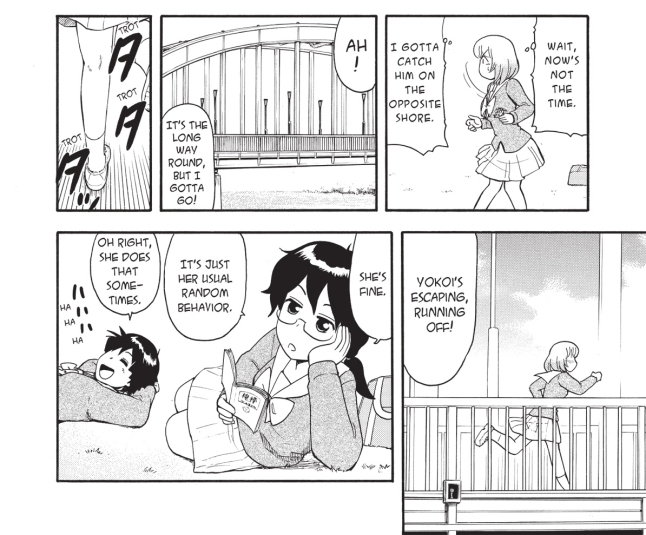
But you must forgive me, I have a lot of other things I want to praise about this manga.
I’ve mentioned how “perceptions” and “rumors” were a factor of the series. Well, due to Yokoi’s antics and her inability to hide any strangeness on her part (unlike Seki, who most believe is a completely ordinary boy), Yokoi is perceived as a weirdo. And she is. But it just really, really amuses me that this girl who starts off seemingly standard and typical goody two shoes even has her friends seeing her running off out of nowhere only to say, “psh, Yokoi” while rolling their eyes.
Speaking of the ever-cute Yokoi, though, another aspect I love is how her attempts at interference frequently either completely don’t work, backfire horribly, or result in utter failure and collapse of this or that (be it an object or more of her reputation). Yokoi is not Seki, after all, and though she’s fairly good at knitting (not sewing, clearly) she otherwise has no particularly notable skills. This basically always gets me. One of my favorite moments in the series involves that idea causing a total subversion of the expected outcome, but I can’t ruin it for you. Seriously though, that’s perfect: her fat butt ruins the Robot Family’s date because she just wasn’t thinking ahead. Other than that, I also enjoy how Yokoi has her own dark streak of a sort.


It’s just lovely.
Oh! And how she’s so expressive! This gets used to the great advantage to a gag that’s nearly meta in one of the chapters, but just try to pay attention to how often and how wildly Yokoi’s expressions change throughout the manga. Heck you can even see it in the pages of this article. It’s great how this just isn’t really mentioned, but it’s fun to observe. Speaking of…
Yokoi herself.
I know it isn’t just me who notices it: Yokoi has a highly appealing, fairly thick figure with obvious hips and a healthy bust. And yet… aside from Gotou being a little too perverted a few times: no real fanservice.
Like… she just has a good body. Well, ain’t that nice. No attention drawn to it whatsoever, though. Not one part. Honestly, I just like that that is an aspect of this series: the main character is rather filled out but it’s on you whether or not that’s worth mentioning or admiring. It is a bit extremely baffling when you realize she’s not in high school, though. Someone matured fast, jeez.
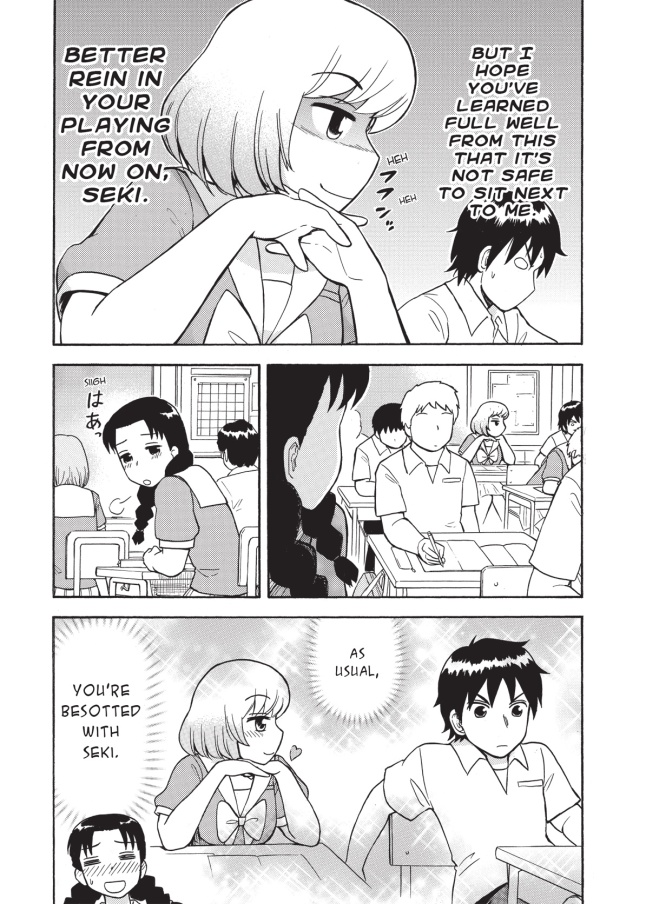
And as for my final notes: first, I ship it (and you probably will too), no matter how much Yokoi doesn’t see him that way and Seki doesn’t care for her at all. I can’t help it. Second, yes like Shakunetsu no Takkyuu Musume they all have pun names:
Yokoi Rumi = “Yoko iru mi” or “looking from the side”
Seki = “Seat” so the title is also “The Seat Next to Me”
Uzawa Akiyasu = Annoying/Loses interest quickly
Maeda = Front (the boy in front of Seki who is large and so blocks the sight of his antics)
Gotou = Back (who sometimes sits behind Yokoi)
Third, the anime (a short form one) is pretty good for an adaptation. Fourth, the live action… not so good, in my opinion. If you haven’t read this, you’ve got ten volumes to go! Get to it! Read it! I highly recommend it, there’s a lot to sink your teeth into and wait in anticipation for.
The series can be purchased from wherever Goodreads points you in English. You can buy it raw from CDJapan, bookwalker (guide), honto (guide), or ebookjapan. You should buy it. It’s such a delightful manga. The official translation is mostly good. I should note it sometimes throws in cursing which… doesn’t feel right (it’s extremely infrequent though in any case), and it can’t entirely decide how to render things like honorifics (whether to keep or ditch them). At least early it also translated Kokkuri-san (an old game) as Oujia, I suppose for localization and the fact that the games are rather similar. Just a few strange choices is all; still good. By the way, just a note: Morishige-sensei actually has another manga up and about (the one he mentioned in volume 10). It’s Voiradi ~Boku no Suki na Personality~ (ボイラジ 〜僕の好きなパーソナリティ〜), a cute and refreshing manga about a VA’s radio broadcasting (hey, familiar) that hasn’t gotten any translations as of yet. It is extremely pleasant.
Oh yes, and Morishige-sensei’s twitter: @morisiget
Thank you very much for bearing with me. I don’t know what will be next for review, but it probably won’t be something Berserk-tier. See you around, boys and girls! Love ya. Ciao. I leave you with this:








































































































































































































































































